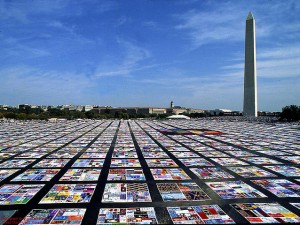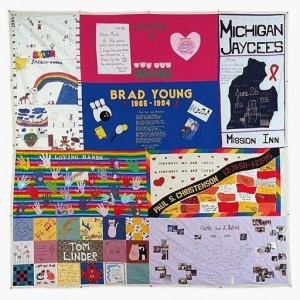
By Tom Peterson
How do you bring your cause to light when it’s invisible? When no one seems to care? These question is asked hundreds of time each day. How is it that these refugees are suffering, that these children are hungry, that this forest is disappearing, that people are dying from this disease… yet no one cares?
Sometimes the use of a powerful symbol can bring shine a light on that invisible issue.
A crisis no one wanted to see
In the early eighties, the mysterious retrovirus AIDS began showing up in the United States. It particularly hit gay men, IV drug users, and those who’d had blood transfusions, such as hemophilacs. In a just a few years AIDS grew to pandemic level. Yet many accused the Reagan administration, because of homophobia, of ignoring the issue. How, wondered gay activists and others, could this crisis get the attention it needed?
In 1985 San Francisco gay rights activist Cleve Jones was on the street stapling posters for an annual candle light march and memorial service for Harvey Milk and George Muscone. In a video interview, he tells of noticing a newspaper headline. It said that a thousand San Franciscans had already died of AIDS. There at the corner of Castro and Market he realized that “almost every one of them had lived and died within six blocks of where I was standing.”
I thought, “What a perfect symbol!”
Jones was frustrated that the suffering and death were invisible. But he had and plenty of poster boards and markers so he asked people at the march to write the names of people they knew who had died. Then using ladders, they taped the posters on the San Francisco Federal Building. When Jones looked it, it reminded him of a quilt.
And when I said quilt to myself I thought of my grandma and my great grandma, and it seemed like such a middle-American family values traditional sort of symbol. And I thought what a perfect symbol to attach to this disease that’s killing homosexuals and African Americans and IV drug users.
Everybody told me it was the stupidest thing they had heard of. It was so nerve-racking. I could just see it in my head so clearly how it would look stretched out on the mall, covering the mall. And I could see how it could work as therapy for people who were grieving, as a tool for the media to understand the lives that were behind the statistics, as a weapon to shame the government for its inaction.
And everybody saying it was really dumb. I always tell young people if you have an idea that you know in your heart you have to do and everybody tells you it totally sucks, just ignore them and do it!”
 AIDS quilt, starting with one panel
AIDS quilt, starting with one panel
That year Jones made the first panel in memory of a friend and invited others to create patches. In 1987 they moved the AIDS memorial quilt to the mall of the nation’s Capital. The giant quilt with 1,920 panels covered two city blocks. In a somber event it was unveiled section-by-section as volunteers read the name of each person who had died—Clayton Berry, Raymond Case, Dave Castro. Parents, siblings, friends, partners and others hugged and cried.
Millions saw the images on television and in their newspapers. The acres of quilt patches said that those who died from AIDS were not statistics but were loved and remembered. The moment personalized AIDS and helped shift America’s will to take greater action. (The quilt, now with 48,000 panels representing 80,000 people, still raises awareness.)
The AIDS Quilt brought an invisible crisis to the American consciousness. How can you use a powerful symbol to help the rest of us see your cause?
Related Posts: Make Your Cause Sticky, Something They’ll Always Remember, Brand Your Cause.
Photos: top, National Institute of Health; bottom, A2JCF Creative Commons.

[…] posts: AIDS Quilt, Pick Your Issue, Strategic Partners for Social […]